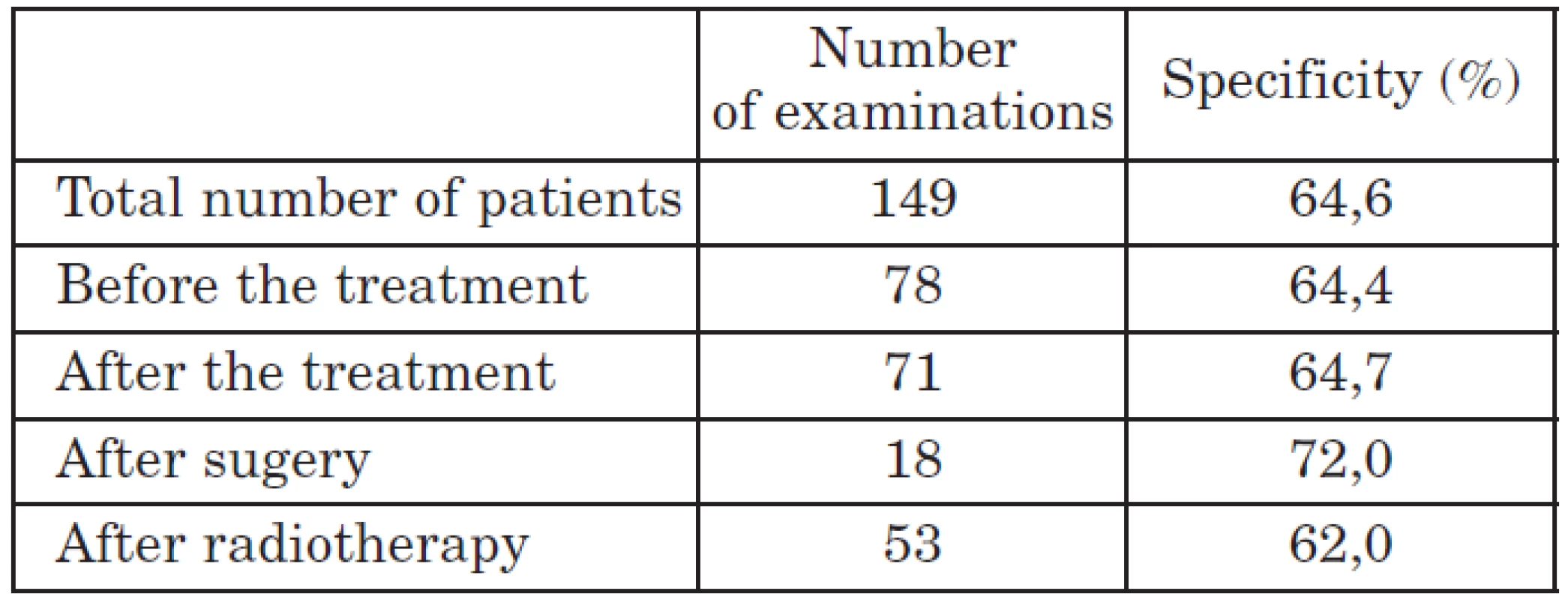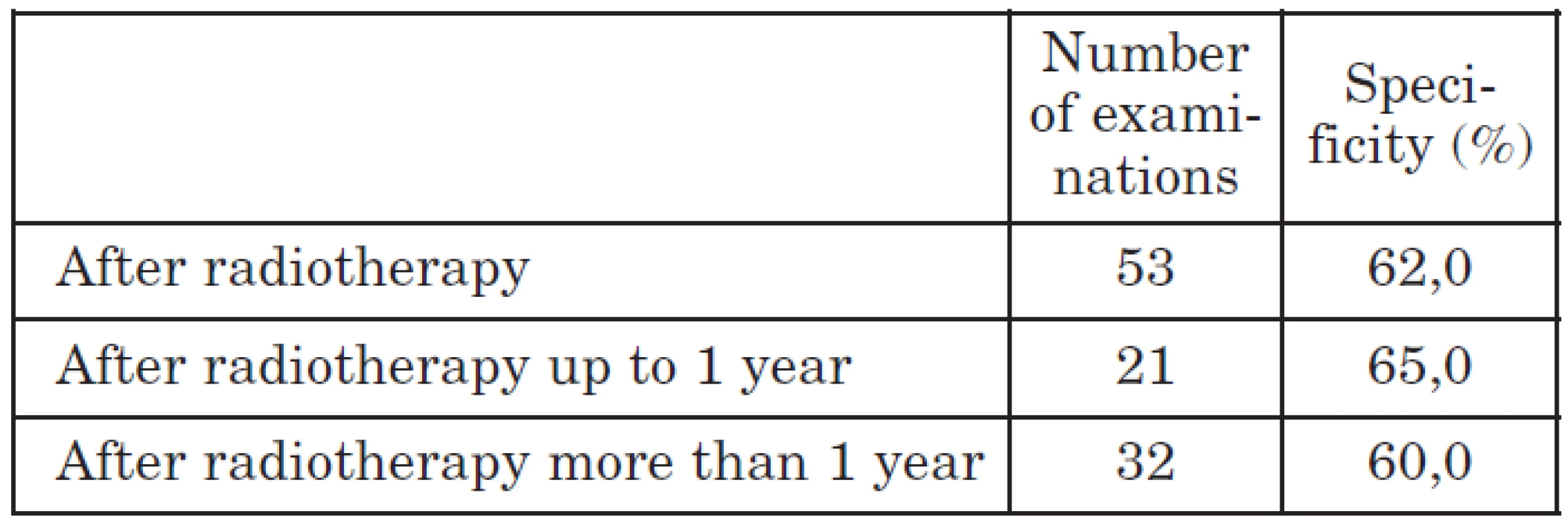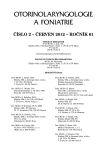Posttreatment Evaluation of Direct Endoscopic Autofluorescence and Its Use in the Management of Laryngeal Cancer
Postterapeutické hodnotenie priamej endoskopickej autofluorescencie a ej použitie v enežmente liečby rakoviny hrtana
Priama endoskopická autofluorescencia hrtana zlepšuje diagnostiku a ohraničenie prekanceróz a karcinómu. Cieľom tejto štúdie je posúdiť diagnostický potenciál a obmedzenia tejto diagnostickej metódy po chirurgickej liečbe a (alebo) po liečbe rádioterapiou. V retrospektívnej štúdii sme urobili 149 vyšetrení u 118 pacientov. Pacientov sme rozdelili do skupín podľa typu liečby a v prípade liečby rádioterapiou aj podľa času medzi autofluorescenčným vyšetrením a ukončením liečby rádioterapiou. Autofluorescencia bola indukovaná pomocou Xenónovej lampy s použitím filtrovaného pásoveho svetla modrej farby (vlnová dĺžka 390 - 470 nm ) a následne zaznamenaná pomocou veľmi citlivej trojčipovej CCD kamery. (DAFE systém firmy Richard Wolf, Knittlingen, Nemecko). Podozrivé ložiská boli vyšetrené direktnou mikrolaryngoskopiou a bola z nich odobratá vzorka na histologické vyšetrenie. Výsledky autofluorescencie sme porovnávali s výsledkami histologických vyšetrení. Výsledky senzitivity a špecificity endoskopickej autofluorescencie sa po liečbe výraznejšie nezmenili a sú porovnateľné s citlivosťou vyšetrenia pred liečbou. Na základe našich výsledkov by sa mohla priama endoskopická autofluorescencia používať aj po chirurgickej liečbe a rádioterapii na dispenzarizáciu pocientov s rakovinou hrtana.
Kľúčové slová:
autofluorescencia, endoskopia, rakovina hrtana, chirurgia, radioterapia.
Authors:
V. Kavečanský 1; I. Čavarga 2; N. Lukán 3; P. Feciskanin 4; P. Bohuš 5
Authors place of work:
ENT Department, ORL Humenné, s. r. o., Humenné, Slovakia
1; Department of Pneumology and Phtiseology, Medical Faculty Safarik University, Košice, Slovakia
2; th Department of Internal Medicine, Medical Faculty Safarik University, Košice, Slovakia
3; ENT Department of Eastern-Slovakian Institute of Oncology, Košice, Slovakia
4; Department of Pathology, Unversity Hospital, Košice, Slovakia
5
Published in the journal:
Otorinolaryngol Foniatr, 61, 2012, No. 2, pp. 95-99.
Category:
Původní práce
Summary
Direct endoscopic autofluorescence of the larynx refines the diagnostic procedure of precancerous lesions and cancer including margins. The aim of our study is to evaluate the diagnostic possibility and limitations of the method after surgical treatment and/or after radiotherapy. 149 examinations in 118 patients were included in a presented retrospective study. Patients were divided into groups according to type of treatment and in case of radiotherapy, according to the time between autofluorescence examination and radiotherapy. Autofluorescence was induced by using a Xenon short–arc lamp (wavelength 390 to 470 nm) and recorded using the three-chip highly sensitive CCD camera (DAFE system, Richard Wolf GmbH, Knittlingen, Germany). Suspicious areas were examined by the direct microlaryngoscopy followed by biopsy confirmation. Autofluorescence results were compared with the biopsies. The results of sensitivity and specificity of endoscopic autofluorescence before and after treatment did not change significantly. Both observed parameters before and after treatment remain comparable. Based on our results direct endoscopic autofluorescence could be used in follow up after surgery as well as after radiotherapy in patients with laryngeal cancer.
Keywords:
autofluorescence, endoscopy, laryngeal cancer, surgery, radiotherapy.
INTRODUCTION
Squamous cell carcinoma covers more than 95% malignant tumors of the larynx. In most cases carcinoma develops from dysplastic (precancerous) lesions of the mucosa (13, 16, 26, 27). Microlaryngoscopy of the larynx, introduced by Kleinsasser in the year 1962 (17) is the standard diagnostic method for the determination the extension of the disease, for carrying out the exact biopsy followed by optimal treatment and follow-up. In the 60 – 70s of 20th century, Kleinsasser method contributed by the considerable merit to the exact diagnostics and observation of dysplastic and malignant lesions of the larynx. This method is not precise to determine the margins of the pathological lesions and relapse of the disease. General anesthesia is also required.
In recent decades, optical methods are being used in the diagnosis of tumors of the mucous membranes of various organs (1, 5, 11, 18). Such methods include also autofluorescence (AF), which is mainly used for early diagnosis (3, 7, 22, 29). Autofluorescence could be used in the follow-up of the patients after surgery or radiotherapy in case of sufficient sensitivity. The aim of this study is to estimate the impact of surgical treatment or radiotherapy on sensitivity and specificity of direct endoscopic autofluorescence.
MATERIAL AND METHODS
In presented retrospective study were included patients with suspected malignant disease of larynx after indirect laryngoscopic examination at the outpatient clinic of Eastern-Slovakian Institute of Oncology. We have also included patients treated for laryngeal cancer before the method has been established. AF method was applied only after the treatment (partial surgery, radiotherapy) in those patients.
Each patient was examined according to the following steps:
1st - indirect laryngoscopy
2nd - direct endoscopic autoflurescence
3rd - histological examination
We evaluated 149 AF laryngeal examinations in 118 patients (109 men and 9 women) during 2005 - 2009. 73 patients had positive biopsy and in 45 cases cancer of the larynx was not histologically confirmed. In cases of histologically confirmed cancer, diagnostic procedure was repeated also after the treatment. Patients after radical surgery (laryngectomy) were excluded from this study. We evaluated only the patients after partial resections of the larynx and after radiotherapy. AF examinations were performed at different stages of the disease before treatment, after surgery (e.g. after chordectomy) and after radiotherapy in different time intervals. Each AF examination was accompanied by the bioptic sample.
Autofluorescence examination was carried out under the local anesthesia (Lidocaine) in outpatient clinic by using AF device DAFE made by Richard Wolf GmbH. Equipment consists of Xenon short–arc lamp which by using filters generates a beam of wavelength 390 to 470 nm, as well as white light. The other parts of this device are flexible bronchoscope, high quality cables to transmit very weak fluorescent light, Three-chip CCD camera, analyzer and documentation unit.
AF examination was accompanied by biopsy of suspicious lesions under the general anesthesia using Kleinsasser method with the help of the operating microscope. Bioptic samples were evaluated by experienced pathologists.
In order to evaluate AF method sensitivity and specificity we used the results of histological examination. Positive lesion was claimed only after histologically confirmed tumorous changes. Lesion with histologically dysplastic changes was included in the group of negative.
Sensitivity and specificity was calculated by using standard methods. Patients were divided into several groups. The response of laryngeal mucosa was analyzed before and after the treatment. Patients after the treatment were divided into two groups (after surgery and after radiotherapy). Patients after radiotherapy were divided into 2 subgroups according to the time between AF examinations and the end of radiotherapy (within one year and more than a year after the radiotherapy).
RESULTS
We evaluated 149 AF laryngeal examinations in 118 patients (109 men and 9 women) during 2005 - 2009. 73 patients had positive biopsy and in 45 cases cancer of the larynx was not histologically confirmed. AF device DAFE made by Richard Wolf GmbH was used in this study. We have not come across the use of this device in the available literature. We are presenting the basic findings of AF examination due to the different colors in comparison with AF devices from other manufactures. (figs. 1).

Figs. 2 shows AF findings after different methods of treatment the laryngeal cancer. We have observed the significant change after surgery with the massive loss of autofluorescence intensity, but not after radiotherapy. Although the surgical treatment causes quantitative change in the AF signal we have not observed the impact of this change on the quality of the signal (wavelength of emitted radiation) and on the sensitivity and specificity of the AF examination. In some patients the blue-light mode brought false positive findings (fig. 2D).

Figs. 3 shows AF findings of the larynx before and after the surgical treatment. As we observed decreased intensity after classical surgical intervention, similar findings was found even after laser surgery.

Figs. 4 shows the findings of the left vocal cord before and at various intervals after the radiotherapy. Not only AF image after the radiotherapy was normalized, but full mobilization of affected vocal cord. No changes in AF signal in different intervals after radiotherapy were observed.

The sensitivity of 100% was estimated in all examined groups. We have noticed the minimal deviations of specificity in all groups (from 6O to 65%) except for the group of patients after surgery, where the specificity of the examination was 72.0% (table 1, table 2).


DISCUSSION
According to the various authors sensitivity of direct endoscopic autofluorescence of laryngeal mucosa reaches 90 - 100%. Specificity of this method is lower, varies according to individual authors from 60 to 90% (2, 6, 8, 20, 23, 29). In our study, we obtained similar results of the sensitivity as well as the specificity. Sensitivity tends to the upper limits and specificity to the lower limits as published by other authors (8, 23, 29). Differences in results may be caused by the use of technical equipment from another manufacturer.
Specificity in each of our groups shows only a little variation. Only in the group after surgery the specificity is significantly higher. Participation of the human factor seems to be one of the major factors as well as the doctor after the successful surgery inclines to the positive results. We assumed that the sensitivity of autofluorescence examination decreases after radiotherapy, in respect to current theories (theories of fluorophores, about the role of hemoglobin and the ratio between NADH and FAD, the theory about role of thickness of the mucosa) on the type of autofluorescence (4, 8) on the one side and the consequences caused by radiotherapy in mucosal tissues and sub mucosal tissue on the other side (9, 10, 12, 14, 15, 24, 28).
It is known that radiotherapy damages healthy tissue especially those containing a high number of mitoses. The laryngeal mucosa also belongs to these tissues. Radiotherapy causes early and late tissue damage (14, 15). Changes the structure of tissues cause the thickening of the mucosa, teleangiectasies, changes the amount of hemoglobin in the submucosa, changes the ratio between collagen and elastin, metabolism decreases in cicatricial tissue (changes the ratio between NADH and FAD), etc. (9, 10, 14, 15, 19, 21, 25).
According to the current theories of AF signal (8) all these changes of mucosa and submucosa could impact the sensitivity and specificity of endoscopic AF. These theories expect decrease of the sensitivity and specificity in the patients after radiotherapy. The results of our study document that the sensitivity and the specificity of endoscopic AF did not change before and after radiotherapy.
We divided the patients after radiotherapy into 2 groups. In the first group patients were examined within 1 year after radiotherapy and the second group of more than 1 year after radiotherapy. We assumed that the first group may have less sensitivity of AF examination, because changes of laryngeal mucosa during the examination by white light in early period after radiotherapy are more significant. In course of time the clinical examination of the laryngeal mucosa modifies and these changes one year after the radiotherapy tend to stabilize. However the results of our endoscopic AF did not follow the clinical finding. We have not observed any changes in the AF examination of the laryngeal mucosa, despite the theories about the impact of mucosal structure and sub mucosal tissue on the AF signal.
We have observed the significant change after surgery with the massive loss of autofluorescence intensity. The cause of this change can not be explained, nor in the available literature, we found an explanation. Although the surgical treatment causes quantitative change in the AF signal we have not observed the impact of this change on the quality of the signal (wavelength of emitted radiation) and on the sensitivity and specificity of the AF examination.
CONCLUSION
Neither radiotherapy, nor surgery affect the specificity and the sensitivity of endoscopic autofluorescence of the laryngeal mucosa. Both parameters remain practically unchanged. Except of primary diagnosis of laryngeal cancer, endoscopic autofluorescence could also be suitable for follow - up the patients with laryngeal cancer after the treatment with radiotherapy or partial surgical procedures.
MUDr. Vojtech Kavečanský
Biela ul. č. 2
040 01 Košice
Slovenská republika
e-mail – vojtechkavecansky@yahoo.com
Zdroje
1. Alfano, R. R., Tata, D. B., Cordero, J., Tomashefsky, P., Longo, F. W., Alfami, M. A.: Laser-induced fluorescence spectroscopy from native cancerous and normal tissue. IEEE J Quant Elektron, 1984, 12, pp. 1507-1511.
2. Arens, C., Dreyer, T., Glanz, H., Malzahn, K.: Indirect autofluorescence laryngoscopy in the diagnosis of laryngeal cancer and its precursor lesions. Eur Arch Otorhinolaryngol., 261, 2004, pp. 71-76.
3. Arens, C., Glanz, H, Dreyer, T., Malzahn, K.: Compact endoscopy of the larynx. Ann Otol Rhinol Laryngol,, 112, 2003, pp. 113-119.
4. Arens, C., Glanz, H., Woenckhaus, J., Hersemeyer, K., Kraft, M.: Histologic assessment of epithelial thickness in early laryngeal cancer or precursor lesions and its impact on endoscopic imaging. Eur Arch Otorhinolaryngol, 264, 2007, pp. 645-649.
5. Arens, C., Malzahn, K., Dias, O., Andrea, M., Glanz, H.: Endoscopic imaging techniques in the diagnosis of laryngeal precursor lesions. Laryngorhinootologie, 78, 1999, pp. 685-691.
6. Arens, C., Reussner, D., Neubacher, H., Woenckhaus, J., Glanz, H.: Spectrometric measurement in laryngeal cancer. Eur Arch Otorhinolaryngol, 263, 2006, pp. 1001-1007.
7. Arens, C., Reussner, D., Woenckhaus, J., Leunig, A., Betz, C. S., Glanz, H.: Indirect fluorescence laryngoscopy in the diagnosis of precancerous and cancerous, laryngeal lesions. Eur Arch Otorhinolaryngol, 264, 2007, pp. 621-626.
8. Betz, C. S., Arens, C., Leunig, A.: Autofluorescence diagnosis of cancers of the upper aerodigestive tract. Endo-Press, Tuttlingen, 2007.
9. Brush, J., Lipnick, S. L., Phillips, T., Sitko, J., McDonald, J. T., McBride, W. H.: Molecular mechanisms of late normal tissue injury. Semin Radiat Oncol (US), 17, 2007, pp. 121-130.
10. Canney, P. A, Dean, S.: Transforming growth factor beta: a promoter of late connective tissue injury following radiotherapy. Br J Radiol, 63, 1990, pp. 620-623.
11. Delank, W., Khanavkar, B., Nakhosteen, J. A., Stoll, W.: A pilot study of autofluorescent endoscopy for the in vivo detection of laryngeal cancer. Laryngoscope, 110, 2000, pp. 368-373.
12. Evans, E. S., Hahn, C. A., Kocak, Z., Zhou, S. M., Marks, L. B.: The role of functional imaging in the diagnosis and management of late normal tissue injury. Semin Radiat Oncol (US), 17, 2007, pp. 72-80.
13. Gale, N., Kambic, V., Michaels, L., Cardesa, A., Hellquist, H., Zidar, N., Poljak, M.: The Ljubljana classification: a practical strategy for the diagnosis of laryngeal precancerous lesions. Adv Anat Pathol, 2000, 7, pp. 240-251.
14. Gupta, N. K., Swindell, R.: Concomitant methotrexate and radiotherapy in advanced head and neck cancer: 15 year follow up of a randomized clinical trial. Clin Oncol, 13, 2001, 339-344.
15. Hall, E. J.: Radiobiology for the radiologist, 4th ed. Lippincott, Philadelphia, PA, 1994, pp. 211-229.
16. Hellquist, H., Cardesa, A., Gale, N., Kambic, V., Michaels, L: Criteria for grading in the Ljubljana classification of epithelial hyperplastic laryngeal lesions; a study by members of the Working Group of Epithelial Hyperplastic Laryngeal Lesions of the European Society of Pathology. Histopathology, 34, 1999, pp. 226-233.
17. Kleinsasser, O.: Die klassifikation und Differentialdiagnose der Epithelhyperplasien der Kehlkopfschleimhaut auf Grund histomorfologischer Merkmale. Z Laryngol Rhinol Otol, 42, 1963, pp. 339-362.
18. Lam, S., Palcic. B.: Autofluorescence bronchoscopy in the detection of squamous metaplasia and dysplasia in current and former smokers. J Nat Cancer Inst, 91, 1999, 561-563.
19. Lee, C. E., Prabhu, Y. V., Slevin, N. J.: Ollagen Vascular Diseases and Enhanced Radiotherapy-induced Normal Tissue Effects - a Case Report and a Review of Published Studies, Clinical Oncology, 23, 2011, pp. 73-78.
20. Malzahn, K., Dreyer, T., Glanz, H., Arens, C.: Autofluorescence endoscopy in the diagnosis of early laryngeal cancer and its precursor lesions. Laryngoscope, 112, 2002, pp. 488-493.
21. Morris, M. M., Powell, S. N.: Irradiation in the setting of collagen vascular disease: acute and late complications. J Clin Oncol, 15, 1997, pp. 2728-2735.
22. Mostafa, B. E, Shafik, A. G., Fawaz, S.: The role of flexible autofluorescence laryngoscopy in the diagnosis of malignant lesions of the larynx. Acta Otolaryngol, 127, 2007, pp. 175-179.
23. Paczona, R., Temam, S., Janot, F., Marandas, P., Luboinski, B.: Autofluorescence videoendoscopy for photodiagnosis of head and neck carcinoma. Eur Arch Otorhinolaryngol, 260, 2003, pp. 544-548.
24. Posner, M. R.: Options in the Treatment of Head and Neck Cancer. CMP Medica, New York, 2006.
25. Ross, J. G., Husary, D. H, Mayr, N. A, Davis, C. S.: Acute and late reactions to radiation therapy in patients with collagen vascular diseases. Cancor, 71, 1993, pp. 3744-3752.
26. Sadri, M., McMahon, J., Parker, A.: Management of laryngeal dysplasia: a review. Eur Arch Otorhinolaryngol, 263, 2006, pp. 843-852.
27. Shanmugaratman, K., Sobin, L. H.: Histological typing of tumours of the upper respiratory tract and ear. WHO international classification of tumours. 2nd ed., Springer, Berlin-Heidelberg-New York, 1991.
28. Steel, G. G.: Basic Clinical Radiobiology. Edward Arnold Publishers, London (GB), 1993.
29. Zargi, M., Fajdiga, I., Smid, L.: Autofluorescence imaging in the diagnosis of laryngeal cancer. Eur Arch Otorhinolaryngol, 257, 2000, pp. 17-23.
Štítky
Audiologie a foniatrie Dětská otorinolaryngologie OtorinolaryngologieČlánek vyšel v časopise
Otorinolaryngologie a foniatrie

2012 Číslo 2
- Akutní respirační infekty a evidence pro probiotické kmeny Limosilactobacillus reuteri
- Isoprinosin je bezpečný a účinný v léčbě pacientů s akutní respirační virovou infekcí
- Podpůrné podávání doplňku stravy BioGaia Pharax při léčbě recidivujících infekcí HCD či faryngitid u dětí – soubor krátkých kazuistik
- Co přinesl klinický výzkum účinků inosin pranobexu a co z toho plyne pro praxi?
Nejčtenější v tomto čísle
- Erythema Multiforme in ENT
- Extranodal NK/T Cell Lymphoma, Nasal Type - an Unusual Cause of Unilateral Nasal Obstruction
- Present View of Adenotomy a Tonsillectomy in the Czech Republic (a questionnaire study)
- Immediate Revision in Patients with Bilateral Recurrent Laryngeal Nerve Palsy after Operation of Thyroid Gland and Parathyroid Glands
